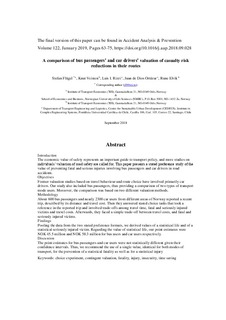| dc.contributor.author | Flugel, Stefan Markus | |
| dc.contributor.author | Veisten, Knut | |
| dc.contributor.author | Rizzi, Luis I. | |
| dc.contributor.author | Ortuzar, Juan De Dios | |
| dc.contributor.author | Elvik, Rune | |
| dc.coverage.spatial | Norway | nb_NO |
| dc.date.accessioned | 2019-06-26T07:52:18Z | |
| dc.date.available | 2019-06-26T07:52:18Z | |
| dc.date.created | 2018-11-05T09:28:36Z | |
| dc.date.issued | 2018-09-22 | |
| dc.identifier.citation | Accident Analysis and Prevention. 2018, 122 (January), 63-75. | nb_NO |
| dc.identifier.issn | 0001-4575 | |
| dc.identifier.uri | http://hdl.handle.net/11250/2602226 | |
| dc.description.abstract | Introduction
The economic value of safety represents an important guide to transport policy, and more studies on individuals’ valuation of road safety are called for. This paper presents a stated preference study of the value of preventing fatal and serious injuries involving bus passengers and car drivers in road accidents.
Objectives
Former valuation studies based on travel behaviour and route choice have involved primarily car drivers. Our study also included bus passengers, thus providing a comparison of two types of transport mode users. Moreover, the comparison was based on two different valuation methods.
Methodology
About 600 bus passengers and nearly 2300 car users from different areas of Norway reported a recent trip, described by its distance and travel cost. Then they answered stated choice tasks that took a reference in the reported trip and involved trade-offs among travel time, fatal and seriously injured victims and travel costs. Afterwards, they faced a simple trade-off between travel costs, and fatal and seriously injured victims.
Findings
Pooling the data from the two stated preference formats, we derived values of a statistical life and of a statistical seriously injured victim. Regarding the value of statistical life, our point estimates were NOK 45.5 million and NOK 58.3 million for bus users and car users respectively.
Discussion
The point estimates for bus passengers and car users were not statistically different given their confidence intervals. Thus, we recommend the use of a single value, identical for both modes of transport, for the prevention of a statistical fatality as well as for a statistical injury | nb_NO |
| dc.language.iso | eng | nb_NO |
| dc.publisher | Elsevier | nb_NO |
| dc.rights | Attribution-NonCommercial-NoDerivatives 4.0 Internasjonal | * |
| dc.rights.uri | http://creativecommons.org/licenses/by-nc-nd/4.0/deed.no | * |
| dc.title | A comparison of bus passengers' and car drivers' valuation of casualty risk reductions in their routes | nb_NO |
| dc.type | Journal article | nb_NO |
| dc.type | Peer reviewed | nb_NO |
| dc.rights.holder | © 2018 Elsevier Ltd. All rights reserved. | nb_NO |
| dc.description.version | acceptedVersion | nb_NO |
| cristin.unitcode | 7482,3,2,0 | |
| cristin.unitcode | 7482,2,4,0 | |
| cristin.unitcode | 7482,2,1,0 | |
| cristin.unitname | Transportmodeller | |
| cristin.unitname | Miljø og klima | |
| cristin.unitname | Sikkerhet og tiltak | |
| cristin.ispublished | true | |
| cristin.fulltext | postprint | |
| cristin.qualitycode | 1 | |
| dc.identifier.doi | 10.1016/j.aap.2018.09.028 | |
| dc.identifier.cristin | 1626907 | |
| dc.source.journal | Accident Analysis and Prevention | nb_NO |
| dc.source.volume | 122 | nb_NO |
| dc.source.issue | January | nb_NO |
| dc.source.pagenumber | 63-75 | nb_NO |
| dc.relation.project | Norges forskningsråd: 155683 | nb_NO |
| dc.relation.project | Norges forskningsråd: 18499/V10 | nb_NO |

